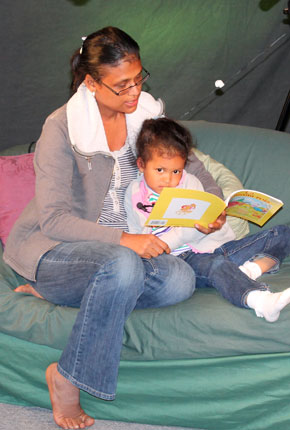- Apply
- Visit
- Request Info
- Give
Dialogic Reading for Multilingual Families
 In 2013, the Center conducted a project funded by the Windham Area Women and Girls Fund of the Community Foundation of Eastern Connecticut. The Dialogic Reading for Multilingual Families project was designed to help address the fund's objective to advance economic security and foster positive engagement for women and girls under age 18.
In 2013, the Center conducted a project funded by the Windham Area Women and Girls Fund of the Community Foundation of Eastern Connecticut. The Dialogic Reading for Multilingual Families project was designed to help address the fund's objective to advance economic security and foster positive engagement for women and girls under age 18.
The Center offered multilingual families, including high school students, the opportunity to participate in training sessions. Dr. Ann Anderberg, a bilingual education professor and expert on bilingual education, led sessions on dialogic reading and supporting dual language learners. All participating families received children's books to keep in both English and their first language, as well as a certificate of completion from the School of Continuing Education.
Interested families were invited to be videotaped reading to their children in English and/or their first language.
Project Goals
-
Research indicates that children who master their first language can easily translate those skills to English. Ensuring that children are read to in their native language by their families helps to continue to develop their language and literacy skills in their native language.
-
Research indicates that children learn most from books when they are actively engaged and involved in the reading. In dialogic reading, the adult "helps the child become the teller of the story" (Whitehurst, 1992) by asking guided questions, listening to children's responses, and helping the child to expand on her answer. Dialogic reading has been shown to improve children's oral language skills and understanding of written language, which impacts their academic and economic success later on.
-
Dr. Ann Anderberg, Principal Investigator
Julia DeLapp, Project Coordinator and Producer
Dr. Carol Williams and Dr. Indira Petosky, Continuing Education and Recruitment Liaisons
Niloufar Rezai, CFDRC Liaison -
For more information or to obtain a DVD of the videos, contact Julia DeLapp, CECE Director, at 860/465-0687.
-
Whitehurst, G. (1992). Dialogic Reading: An effective way to read to preschoolers.

